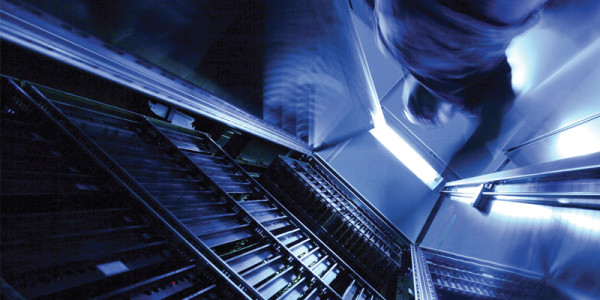Mantraps, access control systems, bollards and surveillance. Your guide to securing the data centre against physical threats and intrusions.
There are plenty of complicated documents that can guide companies through the process of designing a secure data centre—from the gold-standard specs used by the federal government to build sensitive facilities like embassies, to infrastructure standards published by industry groups like the Telecommunications Industry Association, to safety requirements from the likes of the National Fire Protection Association. But what should be the CSO’s high-level goals for making sure that security for the new data centre is built into the designs, instead of being an expensive or ineffectual afterthought?
Read below to find out how a fictional data centre is designed to withstand everything from corporate espionage artists to terrorists to natural disasters. Sure, the extra precautions can be expensive. But they’re simply part of the cost of building a secure facility that also can keep humming through disasters.
- Build on the right spot. Be sure the building is some distance from headquarters (20 miles is typical) and at least 100 feet from the main road. Bad neighbours: airports, chemical facilities, power plants. Bad news: earthquake fault lines and (as we’ve seen all too clearly this year) areas prone to hurricanes and floods. And scrap the “data centre” sign.
- Have redundant utilities. Data centres need two sources for utilities, such as electricity, water, voice and data. Trace electricity sources back to two separate substations and water back to two different main lines. Lines should be underground and should come into different areas of the building, with water separate from other utilities. Use the data centre’s anticipated power usage as leverage for getting the electric company to accommodate the building’s special needs.
- Pay attention to walls. Foot-thick concrete is a cheap and effective barrier against the elements and explosive devices. For extra security, use walls lined with Kevlar.
- Avoid windows. Think warehouse, not office building. If you must have windows, limit them to the break room or administrative area, and use bomb-resistant laminated glass.
- Use landscaping for protection. Trees, boulders and gulleys can hide the building from passing cars, obscure security devices (like fences), and also help keep vehicles from getting too close. Oh, and they look nice too.
- Keep a 100-foot buffer zone around the site. Where landscaping does not protect the building from vehicles, use crash-proof barriers instead. Bollard planters are less conspicuous and more attractive than other devices. Or you could do as Apple and Google have done in hiring security guards.
- Use retractable crash barriers at vehicle entry points. Control access to the parking lot and loading dock with a staffed guard station that operates the retractable bollards. Use a raised gate and a green light as visual cues that the bollards are down and the driver can go forward. In situations when extra security is needed, have the barriers left up by default, and lowered only when someone has permission to pass through.
- Plan for bomb detection. For data centres that are especially sensitive or likely targets, have guards use mirrors to check underneath vehicles for explosives, or provide portable bomb-sniffing devices. You can respond to a raised threat by increasing the number of vehicles you check perhaps by checking employee vehicles as well as visitors and delivery trucks.
- Limit entry points. Control access to the building by establishing one main entrance, plus a back one for the loading dock. This keeps costs down too.
- Make fire doors exit only. For exits required by fire codes, install doors that don’t have handles on the outside. When any of these doors is opened, a loud alarm should sound and trigger a response from the security command centre.
- Use plenty of cameras. Surveillance cameras should be installed around the perimeter of the building, at all entrances and exits, and at every access point throughout the building. A combination of motion-detection devices, low-light cameras, pan-tilt-zoom cameras and standard fixed cameras is ideal. Footage should be digitally recorded and stored offsite.
- Protect the building’s machinery. Keep the mechanical area of the building, which houses environmental systems and uninterruptible power supplies, strictly off limits. If generators are outside, use concrete walls to secure the area. For both areas, make sure all contractors and repair crews are accompanied by an employee at all times.
- Plan for secure air handling. Make sure the heating, ventilating and air-conditioning systems can be set to recirculate air rather than drawing in air from the outside. This could help protect people and equipment if there were some kind of biological or chemical attack or heavy smoke spreading from a nearby fire. For added security, put devices in place to monitor the air for chemical, biological or radiological contaminant.
- Ensure nothing can hide in the walls and ceilings. In secure areas of the data centre, make sure internal walls run from the slab ceiling all the way to subflooring where wiring is typically housed. Also make sure drop-down ceilings don’t provide hidden access points.
- Use two-factor authentication. Biometric identification is becoming standard for access to sensitive areas of data centres, with hand geometry or fingerprint scanners usually considered less invasive than retinal scanning. In other areas, you may be able to get away with less-expensive access cards.
- Harden the core with security layers. Anyone entering the most secure part of the data centre will have been authenticated at least three times, including:
- At the outer door. Don’t forget you’ll need a way for visitors to buzz the front desk.
- At the inner door. Separates visitor area from general employee area.
- At the entrance to the “data” part of the data centre.
- Watch the exits too. Monitor entrance and exit—not only for the main facility but for more sensitive areas of the facility as well. It’ll help you keep track of who was where when. It also helps with building evacuation if there’s a fire.
- Prohibit food in the computer rooms. Provide a common area where people can eat without getting food on computer equipment.
- Install visitor rest rooms. Make sure to include bathrooms for use by visitors and delivery people who don’t have access to the secure parts of the building.





